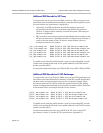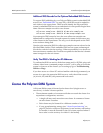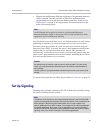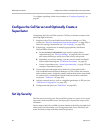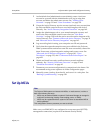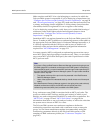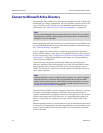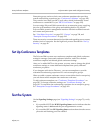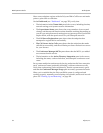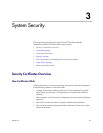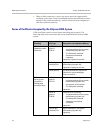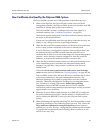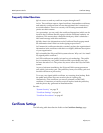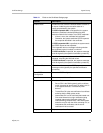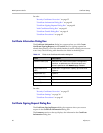
Set Up Conference Templates Polycom
®
DMA
™
System Initial Configuration Summary
Polycom, Inc. 33
Enterprise groups can have their own conference templates that provide a
custom conferencing experience (see “Conference Templates” on page 195).
They can also have their own MCU pool order, which preferentially routes
conferences to certain MCUs (see “MCU Pool Orders” on page 156).
You can assign Polycom DMA system roles to an enterprise group, applying
the roles to all members of the group and enabling them to log into the
Polycom DMA system’s management interface with their standard network
user names and passwords.
See “User Roles Overview” on page 312, “Groups” on page 338, and
“Enterprise Groups Procedures” on page 342.
There are security concerns that need to be addressed regarding user accounts,
whether local or enterprise. See the high-level process described in “Set Up
Security” on page 28.
Set Up Conference Templates
The Polycom DMA system uses conference templates and global conference
settings to manage system and conference behavior, and it has a default
conference template and default global conference settings.
After you’ve added MCUs to the system, you may want to change the global
conference settings or create additional templates that specify different
conference properties.
If you integrate with Active Directory, you can use templates to provide
customized conferencing experiences for various enterprise groups.
When you add a custom conference room to a user (either local or enterprise),
you can choose which template that conference room uses.
To add conference templates, see “Conference Templates Procedures” on
page 220. To change conference settings, see “Conference Settings” on
page 193. To customize the conferencing experience for an enterprise group,
see “Enterprise Groups Procedures” on page 342.
Test the System
On the Signaling Settings page (see “Signaling Settings” on page 71), verify
that:
• If you enabled H.323, the H.323 Signaling Status section indicates that the
signaling status is Active and the port assignments are correct.
• If you enabled SIP, the SIP Signaling Status section shows that the correct
protocols and listening ports are enabled.



